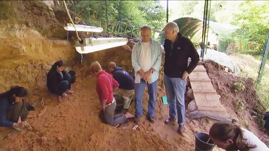Teachers' Domain - Digital Media for the Classroom and Professional Development
User: Preview

Source: The Human Spark: "Becoming Us"




Major funding for The Human Spark is provided by the National Science Foundation, and by the Alfred P. Sloan Foundation. Additional funding is provided by the John Templeton Foundation, the Cheryl and Philip Milstein Family, and The Winston Foundation.
ALAN ALDA (NARRATION) I’m on the trail of these new arrivals, only a few miles from the Neanderthal cave at Roc de Marsal that I visited earlier.
ALAN ALDA Is that Randy?
RANDALL WHITE Welcome to Abri Castanet.
ALAN ALDA (NARRATION) This is another rock shelter called Abri Castanet – a place where there’s little doubt the Human Spark was burning bright.
RANDALL WHITE This is what 33,000 years old looks like. This is a surface that was occupied underneath a rock overhang. The rock shelter was about two meters over the top of people’s heads.
ALAN ALDA And then this all caved in?
RANDALL WHITE It all caved in, collapsed onto the surface.
ALAN ALDA And when did that happen?
RANDALL WHITE That happened about 30,000 years ago.
ALAN ALDA What kind of things are they finding in here?
RANDALL WHITE Well it’s the garbage of everyday life, actually. If you look here and see, here’s a flint tool that was discarded on the surface. Here’s a piece of reindeer antler because the people who lived here hunted reindeer primarily. Here’s another piece of animal bone. We know they were here in the winter. It was 35 degrees below zero when they were living under this rock overhang.
ALAN ALDA So did they make fires in here?
RANDALL WHITE Yeah.
ALAN ALDA Oh, this whole layer here, huh?
RANDALL WHITE This whole black layer here is a rather large fireplace.
ALAN ALDA (NARRATION) On some of the blocks from the fallen roof of the cave, Randy and his team have found engravings – something never seen at Neanderthal sites. But there’s little trace of the humans themselves.
ALAN ALDA What about their own remains? Where would you find their skeletons? RANDALL WHITE This is one of the big puzzles of these modern humans in Europe, is that we don't have any burials. They’re not burying their dead. When we find their skeleton material we find a few remains around a fireplace or something like that, but never full skeletons and…
ALAN ALDA What do you think, they would just leave them lying around?
RANDALL WHITE Well it may be that 20 meters out in front of this rock shelter there was an Aurignacian burial. They may just be burying their people away from the places that they’re actually living. I mean, who wants grandma underfoot when it comes right down to it?
ALAN ALDA Something that’s true of us to this day.
RANDALL WHITE But one of the interesting things that they are doing with their dead people is that they’re extracting their teeth and they’re wearing them as ornaments.
ALAN ALDA Wait a second. So even if grandma kept her teeth in a glass --
RANDALL WHITE Right.
ALAN ALDA …then put them… How do you know they wear them as ornaments? First of all, this is kind of weird. They extracted their teeth? They didn’t just find them from previously dead skeletons.
RANDALL WHITE No. They have, we have pierced human molars from several sites now. They’re drilling holes in the root of the molar and the teeth in two or three cases actually have extraction marks on them and traces of scraping to get the flesh off of them, so they’re –
ALAN ALDA And we’re descended from these people?
RANDALL WHITE Yeah, we are. We are.
 Loading Standards
Loading Standards